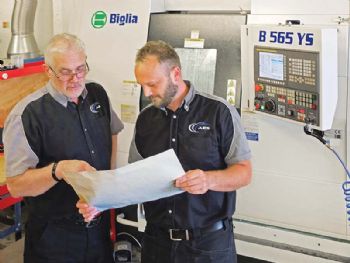
Looking at the cuboid aluminium components produced for medical diagnostic equipment by the family-run sub-contractor AES Precision Engineering, one would think they were milled, drilled and tapped on a machining centre, rather than a lathe.
Indeed, they used to be — from sawn billet in two separate operations on a pair of three-axis vertical-spindle machines in a total cycle time of 12min.
Since April this year, they have been machined complete from round bar in one operation on an Italian-built Biglia B565-YS six-axis turn-mill centre supplied by the manufacturer’s Kenilworth-based UK agent, Whitehouse Machine Tools Ltd (
www.wmtcnc.com).
The program run time has more than halved and is now just 5.5min; moreover, accuracy is improved, and there is no handling between machines or work-in-progress on the shopfloor — significantly reducing the cost of production.
There are only two turning tools in the 12-station turret (for facing the bar end and for parting off), the remainder being axial and radial driven tools.

Mark Wilson, a director of AES Precision Engineering, said: “We have been making these parts for years, during which time the volume has gradually increased to 1,000 per month, so we needed to find a more-efficient way of machining them.
“From visits to trade shows, we were aware of the powerful prismatic machining capabilities of the latest CNC turning centres, and we asked four potential suppliers to offer a turn-key package based on production of the aluminium medical part. Whitehouse demonstrated the best process in terms of quality, capability and cost on a Biglia lathe.”
Counter-spindle
Key attributes of the twin-spindle single-turret machine that secured the purchase by AES are a full C axis on the counter-spindle (essential for this particular job) and a “genuine Y axis” that does not rely on interpolation of the X and C axes to achieve the prismatic shape of the component.
Mr Wilson added that there are no ‘bad’ machine tools these days, although some are more accurate and reliable than others, and that what really makes the difference is the level of service back-up from the supplier.
In this respect, Whitehouse Machine Tools is judged to be exemplary — based on its handling of the enquiry, applications engineering input to date and feedback from other customers it has supplied.
Production engineer Trevor Orman added: “The quality of the Italian lathe is high for this class of machine, which cost under £200,000 with tooling.
“Although tolerances on the medical part are fairly open at 0.1mm, the Biglia repeats to within microns, so we no longer have to chase tolerance all day, as the temperature varies on the shopfloor.
The machine’s accuracy will be invaluable for the production of more tightly toleranced components, while its rigidity means that tool wear is noticeably lower than on our other lathes.”
Having the turn-mill machine has already resulted in a new contract for the manufacture of 316 stainless-steel automotive components that AES Precision Engineering could not have quoted for previously.
Moreover, the company intends to transfer jobs from other lathes to the Biglia to achieve more-economical production. It is also looking for further bar auto work — to a maximum of 70mm in diameter and up to 560mm long and preferably involving runs above 1,000-off — to fill the machine’s capacity.
Founded in 1987 to manufacture components for the medical industry, AES Precision Engineering has since expanded into the automotive, leisure, marine, cosmetics and defence sectors, including the production of complex parts for drones and the reverse-engineering of replacement parts for production lines.
In 2004, the company moved to its present (and larger) premises on the New Street Farm estate in Ashford, Kent. It has invested heavily over the years in a range of new machining centres; these include five-axis models and multi-axis CNC lathes.